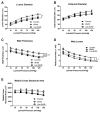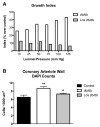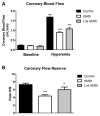The angiotensin receptor blocker losartan reduces coronary arteriole remodeling in type 2 diabetic mice
- PMID: 26133668
- PMCID: PMC5592725
- DOI: 10.1016/j.vph.2015.06.013
The angiotensin receptor blocker losartan reduces coronary arteriole remodeling in type 2 diabetic mice
Abstract
Cardiovascular complications are a leading cause of morbidity and mortality in type 2 diabetes mellitus (T2DM) and are associated with alterations of blood vessel structure and function. Although endothelial dysfunction and aortic stiffness have been documented, little is known about the effects of T2DM on coronary microvascular structural remodeling. The renin-angiotensin-aldosterone system plays an important role in large artery stiffness and mesenteric vessel remodeling in hypertension and T2DM. The goal of this study was to determine whether the blockade of AT1R signaling dictates vascular smooth muscle growth that partially underlies coronary arteriole remodeling in T2DM. Control and db/db mice were given AT1R blocker losartan via drinking water for 4 weeks. Using pressure myography, we found that coronary arterioles from 16-week db/db mice undergo inward hypertrophic remodeling due to increased wall thickness and wall-to-lumen ratio with a decreased lumen diameter. This remodeling was accompanied by decreased elastic modulus (decreased stiffness). Losartan treatment decreased wall thickness, wall-to-lumen ratio, and coronary arteriole cell number in db/db mice. Losartan treatment did not affect incremental elastic modulus. However, losartan improved coronary flow reserve. Our data suggest that Ang II-AT1R signaling mediates, at least in part, coronary arteriole inward hypertrophic remodeling in T2DM without affecting vascular mechanics, further suggesting that targeting the coronary microvasculature in T2DM may help reduce cardiac ischemic events.
Keywords: Angiotensin receptor blocker; Coronary arterioles; Type 2 diabetes mellitus; Vascular remodeling.
Copyright © 2015 Elsevier Inc. All rights reserved.
Figures









Similar articles
-
Coronary arterioles in type 2 diabetic (db/db) mice undergo a distinct pattern of remodeling associated with decreased vessel stiffness.Basic Res Cardiol. 2011 Nov;106(6):1123-34. doi: 10.1007/s00395-011-0201-0. Epub 2011 Jul 10. Basic Res Cardiol. 2011. PMID: 21744279 Free PMC article.
-
Differential coronary resistance microvessel remodeling between type 1 and type 2 diabetic mice: impact of exercise training.Vascul Pharmacol. 2012 Nov-Dec;57(5-6):187-93. doi: 10.1016/j.vph.2012.07.007. Epub 2012 Aug 2. Vascul Pharmacol. 2012. PMID: 22885305 Free PMC article.
-
Involvement of profilin-1 in angiotensin II-induced vascular smooth muscle cell proliferation.Vascul Pharmacol. 2011 Jul-Sep;55(1-3):34-41. doi: 10.1016/j.vph.2011.04.003. Epub 2011 May 6. Vascul Pharmacol. 2011. PMID: 21586339
-
Advances in the treatment of diabetic renal disease: focus on losartan.Curr Med Res Opin. 2004 Mar;20(3):333-40. doi: 10.1185/030079903125003107. Curr Med Res Opin. 2004. PMID: 15025842 Review.
-
Vascular changes in hypertension in response to drug treatment: Effects of angiotensin receptor blockers.Can J Cardiol. 2002 May;18 Suppl A:15A-18A. Can J Cardiol. 2002. PMID: 12045789 Review.
Cited by
-
Reduced stiffness and augmented traction force in type 2 diabetic coronary microvascular smooth muscle.Am J Physiol Heart Circ Physiol. 2020 Jun 1;318(6):H1410-H1419. doi: 10.1152/ajpheart.00542.2019. Epub 2020 May 1. Am J Physiol Heart Circ Physiol. 2020. PMID: 32357115 Free PMC article.
-
Alterations in Coronary Resistance Artery Network Geometry in Diabetes and the Role of Tenascin C.Rev Cardiovasc Med. 2023 Jan 4;24(1):6. doi: 10.31083/j.rcm2401006. eCollection 2023 Jan. Rev Cardiovasc Med. 2023. PMID: 39076867 Free PMC article.
-
Coronary Microvascular Dysfunction in Diabetes Mellitus: Pathogenetic Mechanisms and Potential Therapeutic Options.Biomedicines. 2022 Sep 14;10(9):2274. doi: 10.3390/biomedicines10092274. Biomedicines. 2022. PMID: 36140374 Free PMC article. Review.
-
Interplay of Angiotensin Peptides, Vasopressin, and Insulin in the Heart: Experimental and Clinical Evidence of Altered Interactions in Obesity and Diabetes Mellitus.Int J Mol Sci. 2024 Jan 21;25(2):1310. doi: 10.3390/ijms25021310. Int J Mol Sci. 2024. PMID: 38279313 Free PMC article. Review.
-
Overexpression of p53 due to excess protein O-GlcNAcylation is associated with coronary microvascular disease in type 2 diabetes.Cardiovasc Res. 2020 May 1;116(6):1186-1198. doi: 10.1093/cvr/cvz216. Cardiovasc Res. 2020. PMID: 31504245 Free PMC article.
References
-
- Amiri F, Shaw S, Wang X, Tang J, Waller JL, Eaton DC, Marrero MB. Angiotensin II activation of the JAK/STAT pathway in mesangial cells is altered by high glucose. Kidney Int. 2002;61:1605–1616. - PubMed
-
- Anderson S. Role of local and systemic angiotensin in diabetic renal disease. Kidney Int Suppl. 1997;63:S107–S110. - PubMed
-
- Archer SL. Diversity of phenotype and function of vascular smooth muscle cells. J Lab Clin Med. 1996;127:524–529. - PubMed
-
- Cohn JN, Tognoni G. A randomized trial of the angiotensin-receptor blocker valsartan in chronic heart failure. N Engl J Med. 2001;345:1667–1675. - PubMed
-
- Deedwania P, Srikanth S. Diabetes and vascular disease. Expert Rev Cardiovasc Ther. 2008;6:127–138. - PubMed
MeSH terms
Substances
Grants and funding
LinkOut - more resources
Full Text Sources
Other Literature Sources
Medical
Miscellaneous

